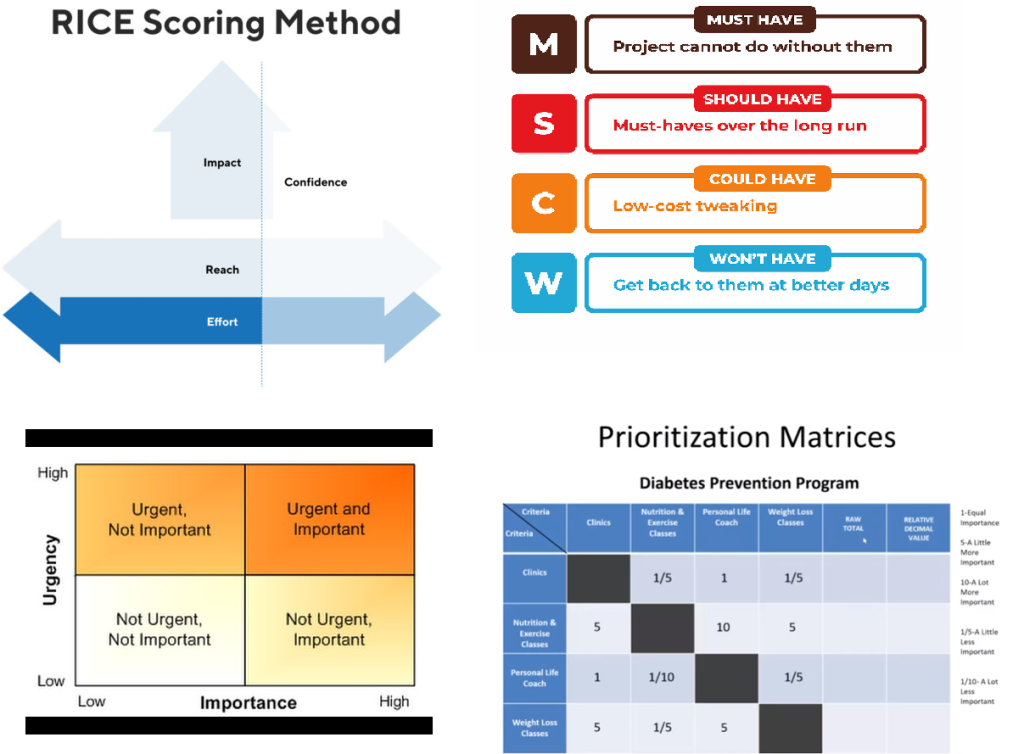In the last blog post, we talked about balanced prioritization. It’s excellent for big-picture-type things like product roadmaps, new technology introduction, and architecture debt management. The balanced prioritization technique helps build north stars (guiding stars) and focus; however, something else is needed when the rubber hits the road. That something is triage prioritization, where people have to “urgently” prioritize to optimize the whole.
Agile pundits like to draw similarities, and this table is some food for thought:
| Types | Other Names A | Other Names B | Other Names C |
| Balanced Prioritization | Deliberate Prioritization | BIG ‘P’ Prioritization | “Strategic” Prioritization |
| Triage Prioritization | Just-in-time (JIT) Prioritization | Small ‘p’ prioritization | “Tactical” Prioritization |
The table below talks about some desired properties of the two:
| Expected Properties | Balanced Prioritization | Triage Prioritization |
| Values | Values multiple viewpoints (customer, leadership, architect, team, market) to prioritize. Consensus driven. | Values newly available learnings/insights to prioritize items. Values collaboration (disagree-and-commit) to consensus. |
| Perspective | Strategic, Long-term | Tactical, Short-term |
| Driven-as | Process-first, driven by people | People-first process, driven by people |
| Time-taken | High. Analysis-biased. It’s an involved process to get feedback, consolidate, review, discuss, and reach consensus. | Short. Action-biased. It’s okay to get it wrong but wrong to waste time in analysis. Values failure to analysis. |
| Assumptions | Largely Independent of any constraints and uncertainties. Weighted-Risk-Assessment approach. | Strives in uncertainties. Uses a mindset of maximizing returns – “effort should not get wasted” and “optimize the whole.” |
| Tools | RISE Score, Prioritization Matrix, Eisenhower Matrix | Communication (say, listen); and a Kanban to track WIP of priority items. |
Okay, so the story 🙂 This story is a personal one:
I have spent most of my career in digitalizing healthcare. The most memorable of this journey was when I spent my time digitalizing emergency care. Emergency care is a hospital department where patients can walk in without an appointment and are assured that they will not be turned away. So, the department gets patients that cannot afford care and patients that need urgent attention. The emergency department is capacity constrained and has to serve a variety of workloads. Most days, it’s just a single emergency, and then there are days where there is a public health emergency or people wheeling in from a significant accident nearby. The department cannot be staffed to handle the worst crisis but is reasonably staffed to handle the typical workload. Then the worst happens – a significant spike in workload – say patients are coming in from a train accident. Some are alive, some are barely alive, and some are dead on arrival. You cannot use a consensus-driven approach to sort these people into an urgent-important matrix or derive a RISE score for each patient. Emergency departments use a scoring system (ESI) where one person identifies the score – “Triage” Nurse; and the team collaborates in the absence of consensus.
I have seen triage nurses shut down the computers, and move to the whiteboard. Computers are great to organize, but organizing is a slow computerized process. Need something faster – whiteboards & instant communication. They don’t need to know the names of the people (patient on bed-2 is a good name). If someone needs help, they shout, and the person who can help offers help.
Commonly heard statements in an emergency care room during high workload emergency:
“That patient is not likely to survive. The damage is beyond repair. Move on, and stop wasting time on this patient.”
“We have only one ventilator. Use this on that younger fellow and not the elderly. We can save more life-hours.”
“That patient is screaming and in pain and will survive if we don’t attend her for the next 45 minutes. She has a fracture. Focus on this patient; our effort here and now can save her leg. We will get back to the screaming one. Somebody shut her up.”
Automated Computerized Workflow can’t respond well to such emergencies. This triage prioritization is a people-first process driven by people. People can increase their capacity – both individually and as a team – in emergencies. People are not like CPUs; they can work at 150% capacity. Capacity is measured not by the elapsed time of effort but outcomes achieved per unit of elapsed time.
End of the day, most people will be saved, and there would be an unfortunate loss. But the triage prioritization values maximizing life hours (optimizing the whole), effort not getting wasted, quick pivot when effort does not yield results (new insights to prioritize), and action bias. The responsibility and authority to prioritize is with the ER care team and stays in those closed doors: the best tools are collaboration and communication (shout, scream, listen, act). When the emergency is behind them, they will retrospect to improve their behavior in an emergency and request for infrastructure that could help them in the future (E.g., that second ventilator could have helped).
Shifting back to software development:
There are parallels in the software team – Tiger team to fix product issues, WAR Room to GO-LIVE, Support Team for 24×7 health of applications in operations during Black Friday, and many more.
While the examples above are like ER teams, triage prioritization also happens in scrum teams executing a well-defined plan. This triage prioritization is hidden from the work tracking boards. When engineers are pair-programming to get something done, many things can go wrong (blind spots) that must be prioritized and fixed. The team cannot fix everything in the sprint duration and carries over some debt. Big Bad debt gets on the boards (some debt remains in code: TODOs). Big Bad debt is prioritized with other big-ticket items using balanced prioritization.
Summary: The outcome quality is directly proportional to triage prioritization, a people-first process driven by people and works best with delegated responsibility and authority.
Some of my friends have argued with me that the story of “mom prioritizing her child’s homework” (last post) is triage prioritization and not balanced prioritization. My friends say, “Mom is the “Triage Nurse” collaborating with the child, and the time taken to prioritize is short, with learnings from execution fed back into the prioritization process.”. There is a grayscale (balanced-triage), and my only argument against the statement above is that mom is not working in a capacity-constrained environment of uncertainties. If she had to choose between a burning car and her child, the choice is obvious.









